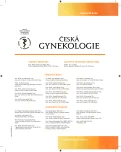Assisted vaginal delivery
Authors:
O. Šimetka 1,2; I. Michalec 1,2
Authors‘ workplace:
Gynekologicko-porodnická klinika Fakultní nemocnice, Ostrava, přednosta kliniky doc. MUDr. O. Šimetka, Ph. D., MBA
1; Katedra gynekologie a porodnictví, Lékařská fakulta, Ostravská univerzita, Ostrava, vedoucí katedrydoc. MUDr. O. Šimetka, Ph. D., MBA
2
Published in:
Ceska Gynekol 2016; 81(2): 129-133
Overview
This article is meant to be a complement to the new statement “Assisted vaginal delivery” of the Section of perinatal and fetomaternal medicine (SPFM) of the Czech Society of Gynecology and Obstetrics ČLS JEP, which is also published in this issue of Czech gynecology. The new statement has been formed as a synthesis of two previous separate statements of the SPFM “Vacuumextraction” and “Forceps delivery” and has also been updated based on new scientific knowledge. This review publication summarizes latest knowledge on vacuumextraction and forceps delivery and adds comments to certain points from the statement.
Design:
A review of the literature.
Keywords:
assisted vaginal delivery, vacuumextraction, forceps, indications, complications
Sources
1. Johanson, R., Menon, V. Soft versus rigid vacuum extractor cups for assisted vaginal delivery. Cochrane Database of Systematic Reviews, 2010, 11. No.: CD000446. DOI: 10.1002/14651858.CD000446.pub2.
2. Johnson, J., Figueroa, R,, Garry, D., et al. Immediate maternal and neonatal effects of forceps and vacuum-assisted deliveries. Obstet Gynec, 2004, 103, 3, p. 513–518.
3. Kolderup, LB., Laros, LK., Musci, TJ. Incidence of persistent birth injury in macrosomic infants: association with mode of delivery. Am J Obstet Gynecol, 1997, 177, p. 37–41.
4. Krofta, L., Otcenasek, M., Kasikova, E., Feyreisl, J. Pubococcygeus-puborectalis trauma after forceps delivery: evaluation of the levator ani muscle with 3D/4D ultrasound. Int Urogyn J, 2009, 20, 10, p. 1175–1181.
5. Liabsuetrakul, T., Choobun, T., Peeyananjarassri, K., Islam, QM. Antibiotic prophylaxis for operative vaginal delivery. Cochrane Database of Systematic Reviews, 2004, 3. Art. No.: CD004455. DOI: 10.1002/14651858.CD004455.pub2.
6. Michalec, I., Simetka, O., Navratilova, M. Vacuum-assisted vaginal delivery and levator ani avulsion in primiparous women. J Matern Fetal Neonatal Med, 2015, 9, p. 1–4. [Epub ahead of print] DOI: 10.3109/14767058.2015.1102223
7. Murphy, DJ., Macleod, M., Bahl, R., et al. A randomised controlled trial of routine versus restrictive use of episiotomy at operative vaginal delivery: a multicentre pilot study. BJOG, 2008, 115, 13, p. 1695–1703.
8. O‘Mahony, F., Hofmeyr, GJ., Menon, V. Choice of instruments for assisted vaginal delivery. Cochrane Database of Systematic Reviews, 2010, 11. No.: CD005455. DOI: 10.1002/14651858.CD005455.pub2.
9. Operative vaginal delivery, RCOG, Guideline No. 26, revised January 2011 (https://www.rcog.org.uk/globalassets/documents/guidelines/gtg_26.pdf).
10. Royal Australian and New Zealand College of Obstetricians and Gynaecologists. Instrumental Vaginal Delivery. College statement No. C-Obs 16 Melbourne: RANZCOG, 2004 (www.ranzcog.edu.au/publications/statements/C-Obs16.pdf).
11. Royal Australian and New Zealand College of Obstetricians and Gynaecologists. Rotational forceps. College statement No. C-Obs 13 Melbourne: RANZCOG, 2015 (www.ranzcog.edu.au/publications/statements/C-Obs13.pdf).
12. Samuelsson, E., Ladfors, L., Wennerholm, UB., et al. Anal sphincter tears: prospective study of obstetric risk factors. Br J Obstet Gynaecol, 2000, 107, p. 926–931.
13. Šimetka, O., Michalec, I. Vakuumextrakce. Čes Gynek, 2010, 75, 5, s. 417–422.
14. Vacca, A., Billings, RG., Vines, VL. Vacuum-assisted delivery. Improving patient outcomes and protecting yourself against litigation. OBG management (Supplement, February 2004). Dostupné z http://clinicalinnovations.com/wp-content/uploads/2015/03/OBGMgmtSupplement.pdf
Labels
Paediatric gynaecology Gynaecology and obstetrics Reproduction medicineArticle was published in
Czech Gynaecology

2016 Issue 2
Most read in this issue
- Current status and recommendations for intrapartum monitoring of fetal heart rate
- Induction of labor
- Posterm pregnancy
- Delivery of macrosomic fetus
